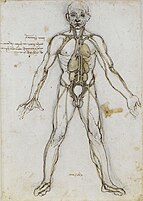
Photo from wikipedia
BACKGROUND Cases of nail gun injuries to the head and neck are rare, and treatment approach varies with each case based on location and extent of injury. CASE DESCRIPTION We… Click to show full abstract
BACKGROUND Cases of nail gun injuries to the head and neck are rare, and treatment approach varies with each case based on location and extent of injury. CASE DESCRIPTION We present a case of a 52-year-old male who fell off a roof holding a pneumatic nail gun and accidentally shot himself with a nail through the right frontal neck region. The nail penetrated the right sternocleidomastoid muscle and extended intracranially through the right occipital condyle with its tip embedded in the right cerebellar hemisphere. The nail coursed between the right distal cervical internal jugular vein and right internal carotid artery. There was no evidence of vascular injury on initial imaging. The barbs of the nail abutted the right sigmoid sinus, making for high risk of tear and intracranial hemorrhage on manual nail extraction. Therefore preemptive coil embolization of the right dural venous sigmoid and occipital sinuses and internal jugular bulb was performed before attempted nail removal. Using biplane fluoroscopy, orthopedic screw removal plyers were successful in snaring the head of the nail. On initial removal attempt, the head of the nail injured the distal right cervical internal carotid artery, requiring endovascular coil embolization. The nail was then successfully extracted from the neck without further immediate complications. CONCLUSION Use of biplane fluoroscopy and preemptive endovascular embolization makes a nonsurgical approach to penetrating skull base injuries feasible. Despite improving right visual loss related to the right internal carotid artery embolization, the patient had no new focal neurologic deficits on 1-month outpatient follow-up.
Journal Title: World neurosurgery
Year Published: 2018
Link to full text (if available)
Share on Social Media: Sign Up to like & get
recommendations!